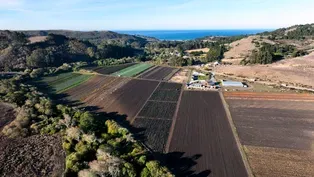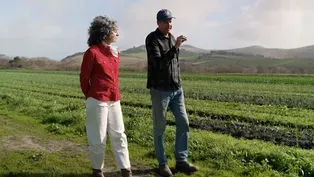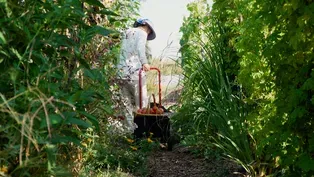
Dryland Wheat Farmers
Clip: 8/16/2024 | 4m 35sVideo has Closed Captions
Meet farmers growing wheat in a very dry climate.
A look at the challenges faced by farmers who grow wheat in places with little to no rainfall in the spring and summer, including here in Eastern Washington.
America's Heartland is presented by your local public television station.
Funding for America’s Heartland is provided by US Soy, Sustainable Agriculture Research and Education, Rural Development Partners, and a Specialty Crop Grant from the California Department of Food and Agriculture.

Dryland Wheat Farmers
Clip: 8/16/2024 | 4m 35sVideo has Closed Captions
A look at the challenges faced by farmers who grow wheat in places with little to no rainfall in the spring and summer, including here in Eastern Washington.
How to Watch America's Heartland
America's Heartland is available to stream on pbs.org and the free PBS App, available on iPhone, Apple TV, Android TV, Android smartphones, Amazon Fire TV, Amazon Fire Tablet, Roku, Samsung Smart TV, and Vizio.
Providing Support for PBS.org
Learn Moreabout PBS online sponsorship♪♪♪ Narr: This vast landscape of gray skies and steady winds may suggest a place blessed by abundant rain.
But this cloudy June day in eastern Washington is misleading.
Farmer Ron Jirava, whose family's been working this land since 1884, says each season they plant and pray the heavens will provide enough moisture to sustain their winter wheat.
Ron: It comes only in the winter.
it's not reliable as far as how much we're going to get each winter.
But a lot of these crops, like some moisture in the spring, and it's been known to stop raining and any kind of precipitation from February on.
It makes it kind of difficult.
Narr: With rainfall so scarce, the prospect of a disappointing harvest and financial distress has always been part of life for these dry land farmers.
But in 1915, Washington State University began researching ways to coax more abundance from this parched and dusty soil.
It created the Dry land research station, laboratories, machine shops for new farm inventions, and more than 1300 acres of land for experimental planting.
Bill: I like being able to think I'm doing something useful.
Narr: Bill Schillinger is a scientist, professor, and the director of the station.
Bill: Are we operating in isolation?
In a way, yes, because no one else has such unique environments.
We're in our winter rainfall region with dry summers.
The circle I work in is, first, let's keep the soil from blowing.
So we need conservation, soil management, Narr: Preventing erosion, and conserving precious topsoil does more than help farmers grow bigger crops.
As Bill showed me, it keeps the air cleaner for the rest of us.
Bill: You know, take a stable clod.
It doesn't take much to pulverize it.
And then when you pulverize it and it goes in the air.
Narr: Nothing but dust.
Bill: And, the stuff you can't see is still in the air.
Whenever there's a dust storm, whenever there's an exceedance of the federal air standard, it's always, always associated with high wind events and blowing dust from agricultural fields.
And so researchers and wheat growers fess up.
So that's what we really want to stop.
In the past, farmers here grew only winter wheat planted in the fall, harvested in the summer.
That meant fields lying bare or fallow, often for months.
With dryland research help, farmers are trying new crop rotations to reduce dangerous dust, and they're assisting with test plots like these around Jiravas farm.
This all in addition to no-till farming, where crop residue from the last harvest is left on the ground.
Wheat is nearly a $1 billion industry in Washington, its third biggest crop behind apples and dairy products, and up to 90% of Washington wheat growers are completely dependent on rainfall.
For Bill and his team, it's a big responsibility improving crops and air quality.
But the payoff is work that not only sustains vital production but ultimately keeps prices down on a vast array of consumer products.
Bill: It sounds corny, but I really am passionate about my job, and it's great to get paid to do what I'm passionate about.
We work with progressive farmers who feel the same way and are leading the pack, and that's how we're going to make it happen.
Narr: In an average year, American farmers raise more than 2 billion bushels of wheat.
The grain is grown in 42 states across the country on nearly 63 million acres of land.
Wheat is critical as a food resource.
One bushel of wheat can make more than 75 1 pound loaves of bread.
And did you know that more food is made from wheat than any other cereal grain?
You'll find wheat in breakfast cereals, pasta, pizza, tortillas, and other foods that depend on flour like your birthday cake.
Video has Closed Captions
A farmer builds housing for his workers right on the land. (4m 24s)
Diversified Farms – Harvesting Health
Video has Closed Captions
Our health expert explains why farms that grow a diverse range of crops may be better for our health (4m 39s)
Growing Opportunities for Refugees
Video has Closed Captions
Visit a farm run by the International Rescue Committee that provides refugees a place to grow. (5m 33s)
White Bean Dip – Farm to Fork with Sharon Profis
Video has Closed Captions
Discover how to make a white bean dip appetizer. (4m 1s)
Providing Support for PBS.org
Learn Moreabout PBS online sponsorshipAmerica's Heartland is presented by your local public television station.
Funding for America’s Heartland is provided by US Soy, Sustainable Agriculture Research and Education, Rural Development Partners, and a Specialty Crop Grant from the California Department of Food and Agriculture.















